steering wheel LEXUS RCF 2021 Owners Manual
[x] Cancel search | Manufacturer: LEXUS, Model Year: 2021, Model line: RCF, Model: LEXUS RCF 2021Pages: 408, PDF Size: 8.25 MB
Page 2 of 408

2TABLE OF CONTENTS
For your information ......................................6
Reading this manual .................................... 10
How to search ................................................. 11
Pictorial index ................................................. 12
1-1. For safe use Before driving .................................... 22
For safe driving.................................. 23
Seat belts ............................................. 24
SRS airbags ....................................... 28
Front passenger occupant classifi- cation system ................................. 36
Exhaust gas precautions ................ 41
1-2. Child safety Riding with children......................... 42
Child restraint systems .................. 42
1-3. LEXUS Enform Lexus Enform Safety Connect .. 53
1-4. Theft deterrent system Engine immobilizer system ......... 57
Alarm.................................................... 58
Theft prevention labels (U.S.A.) .............................................................. 60
2-1. Instrument cluster Warning lights and indicators ..... 62
Gauges and meters ....................... 66
Multi-information display............. 73
Fuel consumption information ... 833-1. Key information
Keys ...................................................... 88
3-2. Opening, closing and locking the doors and trunk
Doors .................................................... 92
Trunk ..................................................... 95
Smart access system with push-but- ton start ............................................ 98
3-3. Adjusting the seats Front seats........................................ 103
Power easy access system/driving position memory/memory recall
function........................................... 105
3-4. Adjusting the steering wheel and mirrors
Steering wheel ............................... 108
Inside rear view mirror ............... 109
Outside rear view mirrors.......... 110
3-5. Opening, closing the windows and moon roof
Power windows ............................... 112
Moon roof .......................................... 114
4-1. Before driving Driving the vehicle......................... 118
Cargo and luggage....................... 124
Vehicle load limits.......................... 126
Trailer towing................................... 127
Dinghy towing ................................. 127
4-2. Driving procedures Engine (ignitio n) switch .............. 128
1For safety and security
2Vehicle status information and
indicators
3Before driving
4Driving
Page 3 of 408
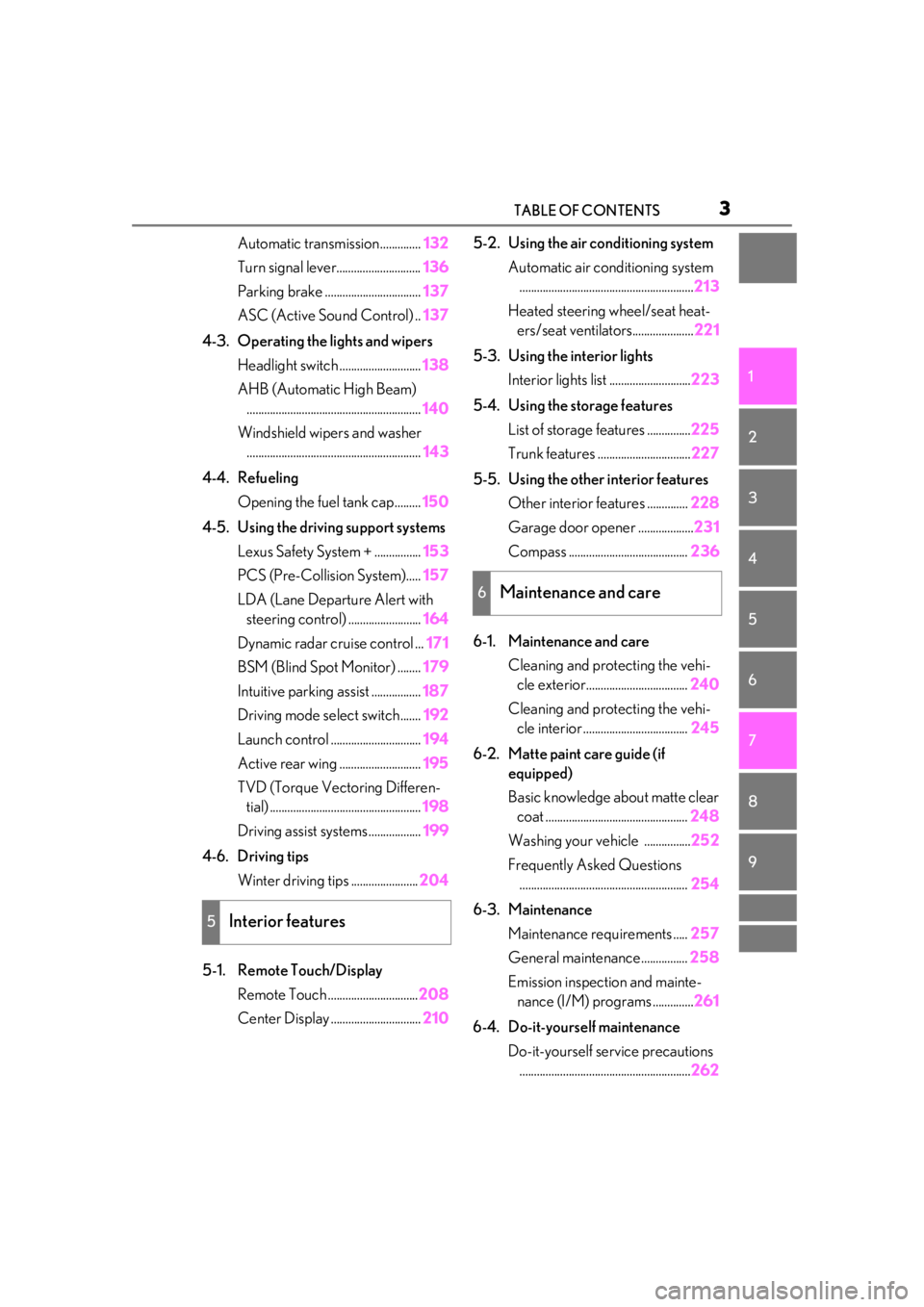
3TABLE OF CONTENTS
1
2
3
4
5
6
7
8
9
Automatic transmission..............132
Turn signal lever............................. 136
Parking brake ................................. 137
ASC (Active Sound Control) .. 137
4-3. Operating the lights and wipers Headlight switch ............................ 138
AHB (Automatic High Beam) ............................................................ 140
Windshield wipers and washer ............................................................ 143
4-4. Refueling Opening the fuel tank cap......... 150
4-5. Using the driving support systems Lexus Safety System + ................ 153
PCS (Pre-Collision System)..... 157
LDA (Lane Departure Alert with steering control) ......................... 164
Dynamic radar cruise control ... 171
BSM (Blind Spot Monitor) ........ 179
Intuitive parking assist ................. 187
Driving mode select switch....... 192
Launch control ............................... 194
Active rear wing ............................ 195
TVD (Torque Vect oring Differen-
tial) .................................................... 198
Driving assist systems .................. 199
4-6. Driving tips Winter driving tips ....................... 204
5-1. Remote Touch/Display Remote Touch ............................... 208
Center Display ............................... 2105-2. Using the air conditioning system
Automatic air conditioning system............................................................ 213
Heated steering wheel/seat heat- ers/seat ventilators..................... 221
5-3. Using the interior lights Interior lights list ............................ 223
5-4. Using the storage features List of storage features ............... 225
Trunk features ................................ 227
5-5. Using the other interior features Other interior features .............. 228
Garage door opener ................... 231
Compass ......................................... 236
6-1. Maintenance and care Cleaning and protecting the vehi-cle exterior................................... 240
Cleaning and protecting the vehi- cle interior .................................... 245
6-2. Matte paint care guide (if equipped)
Basic knowledge about matte clear coat ................................................. 248
Washing your vehicle ................ 252
Frequently Asked Questions .......................................................... 254
6-3. Maintenance Maintenance re quirements .....257
General maintenance................ 258
Emission inspection and mainte- nance (I/M) programs .............. 261
6-4. Do-
it-yourself maintenance
Do-it-yourself service precautions ........................................................... 262
5Interior features
6Maintenance and care
Page 18 of 408

18Pictorial index
Seat heater switches*1........................................................................................... P.221
Seat ventilator switches
*1....................................................................................P.222
Heated steering wheel switch
*1.......................................................................... P.221
Driving mode select switch .................................................................................. P.192
VSC OFF switch.................................................................................................... P.200
“LAUNCH” switch ................................................................................................. P.194
“TVD” switch
*1.........................................................................................................P.198
Remote Touch
*2.................................................................................................... P.208
*1: If equipped
*2: Refer to “NAVIGATION AND MULTIMEDIA SYSTEM OWNER’S MANUAL”.
A
B
C
D
E
F
G
H
Page 23 of 408
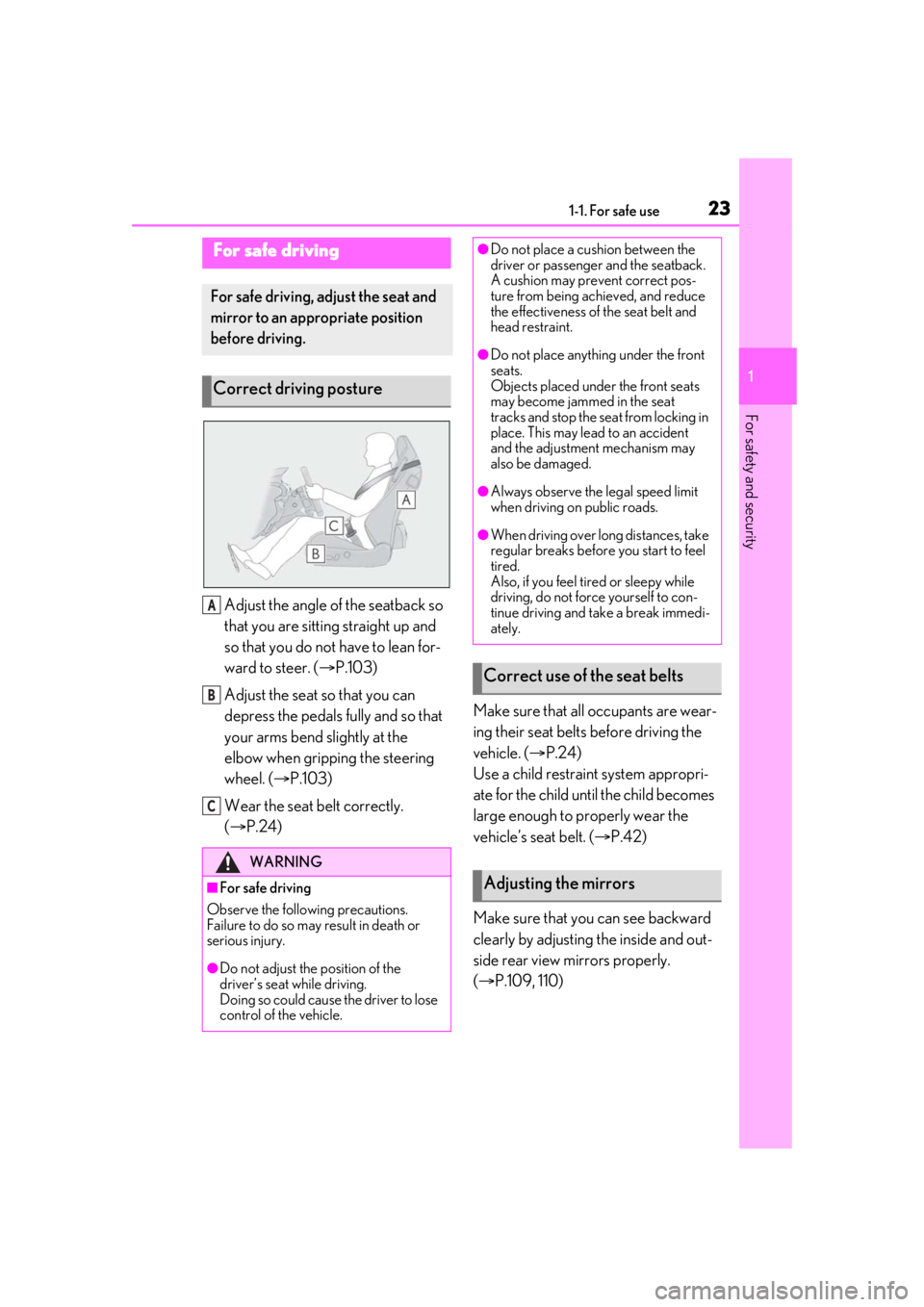
231-1. For safe use
1
For safety and security
Adjust the angle of the seatback so
that you are sitting straight up and
so that you do not have to lean for-
ward to steer. (P.103)
Adjust the seat so that you can
depress the pedals fully and so that
your arms bend slightly at the
elbow when gripping the steering
wheel. ( P.103)
Wear the seat belt correctly.
( P.24) Make sure that all occupants are wear-
ing their seat belts before driving the
vehicle. (
P.24)
Use a child restraint system appropri-
ate for the child until the child becomes
large enough to properly wear the
vehicle’s seat belt. ( P.42)
Make sure that you can see backward
clearly by adjusting the inside and out-
side rear view mirrors properly.
( P.109, 110)
For safe driving
For safe driving, adjust the seat and
mirror to an appropriate position
before driving.
Correct driving posture
WARNING
■For safe driving
Observe the following precautions.
Failure to do so may result in death or
serious injury.
●Do not adjust the position of the
driver’s seat while driving.
Doing so could cause the driver to lose
control of the vehicle.
A
B
C
●Do not place a cushion between the
driver or passenger and the seatback.
A cushion may prevent correct pos-
ture from being achieved, and reduce
the effectiveness of the seat belt and
head restraint.
●Do not place anything under the front
seats.
Objects placed under the front seats
may become jammed in the seat
tracks and stop the seat from locking in
place. This may lead to an accident
and the adjustment mechanism may
also be damaged.
●Always observe the legal speed limit
when driving on public roads.
●When driving over long distances, take
regular breaks before you start to feel
tired.
Also, if you feel tired or sleepy while
driving, do not force yourself to con-
tinue driving and take a break immedi-
ately.
Correct use of the seat belts
Adjusting the mirrors
Page 30 of 408

301-1. For safe use
shown in the system components diagram above. This information includes crash
severity and occupant information. As the airbags deploy, a chemical reaction in
the inflators quickly fills the airbags with no n-toxic gas to help restrain the motion of
the occupants.
■If the SRS airbags deploy (inflate)
●Slight abrasions, burns, bruising etc., may
be sustained from SRS airbags, due to the
extremely high speed deployment (infla-
tion) by hot gases.
●A loud noise and white powder will be
emitted.
●Parts of the airbag module (steering
wheel hub, airbag cover and inflator) as
well as the front seat s, parts of the front
and rear pillars, and roof side rails, may
be hot for several minutes. The airbag
itself may also be hot.
●The windshield may crack.
●For Lexus Enform Safety Connect sub-
scribers, if the SRS airbags deploy or in
the event of a severe rear-end collision,
the system is designed to send an emer-
gency call to the response center, notify-
ing them of the vehicl e’s location (without
needing to push the “SOS” button) and
an agent will attempt to speak with the
occupants to ascertain the level of emer-
gency and assistance required. If the
occupants are unable to communicate,
the agent automatically treats the call as
an emergency and helps to dispatch the
necessary emergency services. ( P.53)
■SRS airbag deployment conditions (SRS
front airbags)
●The SRS front airbags will deploy in the
event of an impact that exceeds the set
threshold level (the level of force corre-
sponding to an approximately 12 - 18
mph [20 - 30 km/h] frontal collision with
a fixed wall that does not move or
deform).
However, this threshold velocity will be
considerably higher in the following situa-
tions:
• If the vehicle strikes an object, such as a
parked vehicle or sign pole, which can
move or deform on impact
• If the vehicle is involved in an underride collision, such as a collision in which the
front of the vehicle “underrides”, or goes
under, the bed of a truck
●Depending on the type of collision, it is
possible that only the seat belt preten-
sioners will activate.
●The SRS front airbags for the front pas-
senger will not activate if there is no pas-
senger sitting in the front passenger seat.
However, the SRS front airbags for the
front passenger may deploy if luggage is
put in the seat, even if the seat is unoccu-
pied.
■SRS airbag deployment
conditions (SRS
side and curtain shield airbags)
●The SRS side and curtain shield airbags
will deploy in the event of an impact that
exceeds the set threshold level (the level
of force corresponding to the impact
force produced by an approximately
3300 lb. [1500 kg] vehicle colliding with
the vehicle cabin from a direction per-
pendicular to the vehicle orientation at an
approximate speed of 12 - 18 mph [20 -
30 km/h]).
●The SRS curtain shield airbags will deploy
in the event of vehicle rollover.
●The SRS side and curtain shield airbags
will deploy in the event of a severe frontal
collision.
■Conditions under which the SRS air-
bags may deploy (inflate), other than a
collision
The SRS front airbags and SRS side and
curtain shield airbags may also deploy if a
serious impact occurs to the underside of
your vehicle. Some examples are shown in
the illustration.
●Hitting a curb, edge of pavement or hard
surface
●Falling into or jumping over a deep hole
●Landing hard or falling
Page 32 of 408
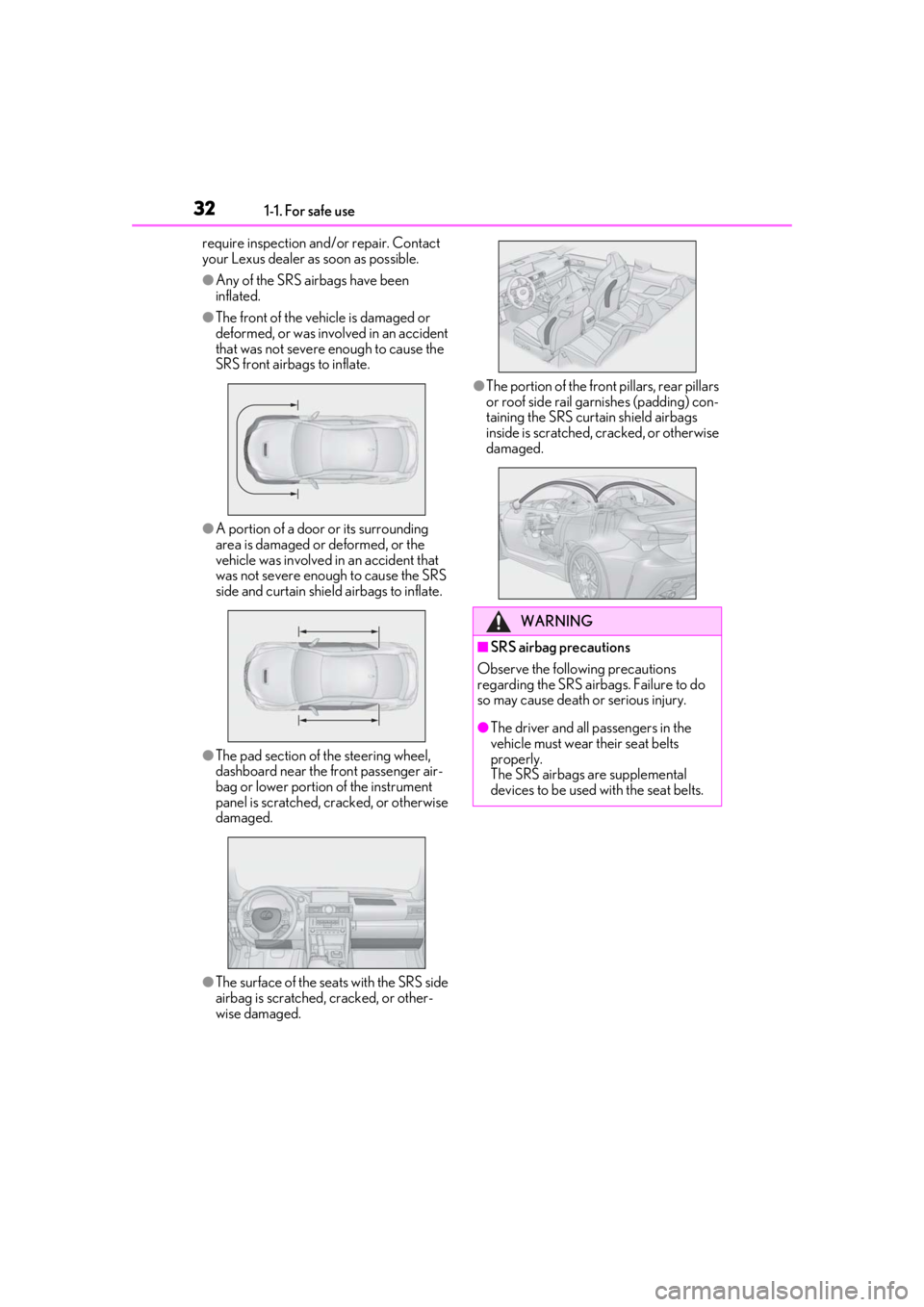
321-1. For safe use
require inspection and/or repair. Contact
your Lexus dealer as soon as possible.
●Any of the SRS airbags have been
inflated.
●The front of the vehicle is damaged or
deformed, or was involved in an accident
that was not severe enough to cause the
SRS front airbags to inflate.
●A portion of a door or its surrounding
area is damaged or deformed, or the
vehicle was involved in an accident that
was not severe enough to cause the SRS
side and curtain shield airbags to inflate.
●The pad section of the steering wheel,
dashboard near the front passenger air-
bag or lower portion of the instrument
panel is scratched, cracked, or otherwise
damaged.
●The surface of the seats with the SRS side
airbag is scratched, cracked, or other-
wise damaged.
●The portion of the front pillars, rear pillars
or roof side rail garnishes (padding) con-
taining the SRS curtain shield airbags
inside is scratched, cracked, or otherwise
damaged.
WARNING
■SRS airbag precautions
Observe the following precautions
regarding the SRS airb ags. Failure to do
so may cause death or serious injury.
●The driver and all passengers in the
vehicle must wear their seat belts
properly.
The SRS airbags are supplemental
devices to be used with the seat belts.
Page 33 of 408

331-1. For safe use
1
For safety and security
WARNING
●The SRS driver airbag deploys with
considerable force, and can cause
death or serious injury especially if the
driver is very close to the airbag. The
National Highway Traffic Safety
Administration (NHTSA) advises:
Since the risk zone for the driver’s air-
bag is the first 2 - 3 in. (50 - 75 mm) of
inflation, placing yourself 10 in. (250
mm) from your driver airbag provides
you with a clear margin of safety. This
distance is measured from the center
of the steering wheel to your breast-
bone. If you sit less than 10 in. (250
mm) away now, you can change your
driving position in several ways:
• Move your seat to the rear as far as you can while still reaching the pedals
comfortably.
• Slightly recline the back of the seat. Although vehicle designs vary, many
drivers can achieve the 10 in. (250
mm) distance, even with the driver seat
all the way forward, simply by reclining
the back of the se at somewhat. If
reclining the back of your seat makes it
hard to see the road, raise yourself by
using a firm, non-slippery cushion, or
raise the seat if your vehicle has that
feature.
• If your steering wheel is adjustable, tilt it downward. This points the airbag
toward your chest instead of your head
and neck.
The seat should be adjusted as recom-
mended by NHTSA above, while still
maintaining control of the foot pedals,
steering wheel, and your view of the
instrument panel controls.
●If the seat belt extender has been con-
nected to the front seat belt buckles
but the seat belt extender has not also
been fastened to the latch plate of the
seat belt, the SRS front airbags will
judge that the driver and front passen-
ger are wearing the seat belt even
though the seat belt has not been con-
nected. In this case, the SRS front air-
bags may not activate correctly in a
collision, resulting in death or serious
injury in the event of a collision. Be
sure to wear the seat belt with the seat
belt extender.
●The SRS front passenger airbag also
deploys with considerable force, and
can cause death or serious injury
especially if the front passenger is very
close to the airbag. The front passen-
ger seat should be as far from the air-
bag as possible with the seatback
adjusted, so the front passenger sits
upright.
●Improperly seated and/or restrained
infants and children can be killed or
seriously injured by a deploying airbag.
An infant or child who is too small to
use a seat belt should be properly
secured using a child restraint system.
Lexus strongly recommends that all
infants and children be placed in the
rear seats of the vehicle and properly
restrained. The rear seats are safer for
infants and children than the front pas-
senger seat. (
P.42)
Page 34 of 408

341-1. For safe use
WARNING
●Do not sit on the edge of the seat or
lean against the dashboard.
●Do not allow a child to stand in front of
the SRS front passenger airbag unit or
sit on the knees of a front passenger.
●Do not allow the front seat occupants
to hold items on their knees.
●Do not lean against the door, the roof
side rail or the front, side and rear pil-
lars.
●Do not allow anyone to kneel on the
passenger seats toward the door or
put their head or hands outside the
vehicle.
●Do not attach anything to or lean any-
thing against areas such as the dash-
board, steering wheel pad and lower
portion of the instrument panel.
These items can become projectiles
when the SRS driver, front passenger
and knee airbags deploy.
●Do not attach anything to areas such
as a door, windshield, side windshield,
front or rear pillar, roof side rail and
assist grip.
(Except for the speed limit sticker
P.321)
●Do not hang coat hangers or hard
objects on the coat hooks. All of these
items could become projectiles and
may cause death or serious injury,
should the SRS curtain shield airbags
deploy.
Page 35 of 408
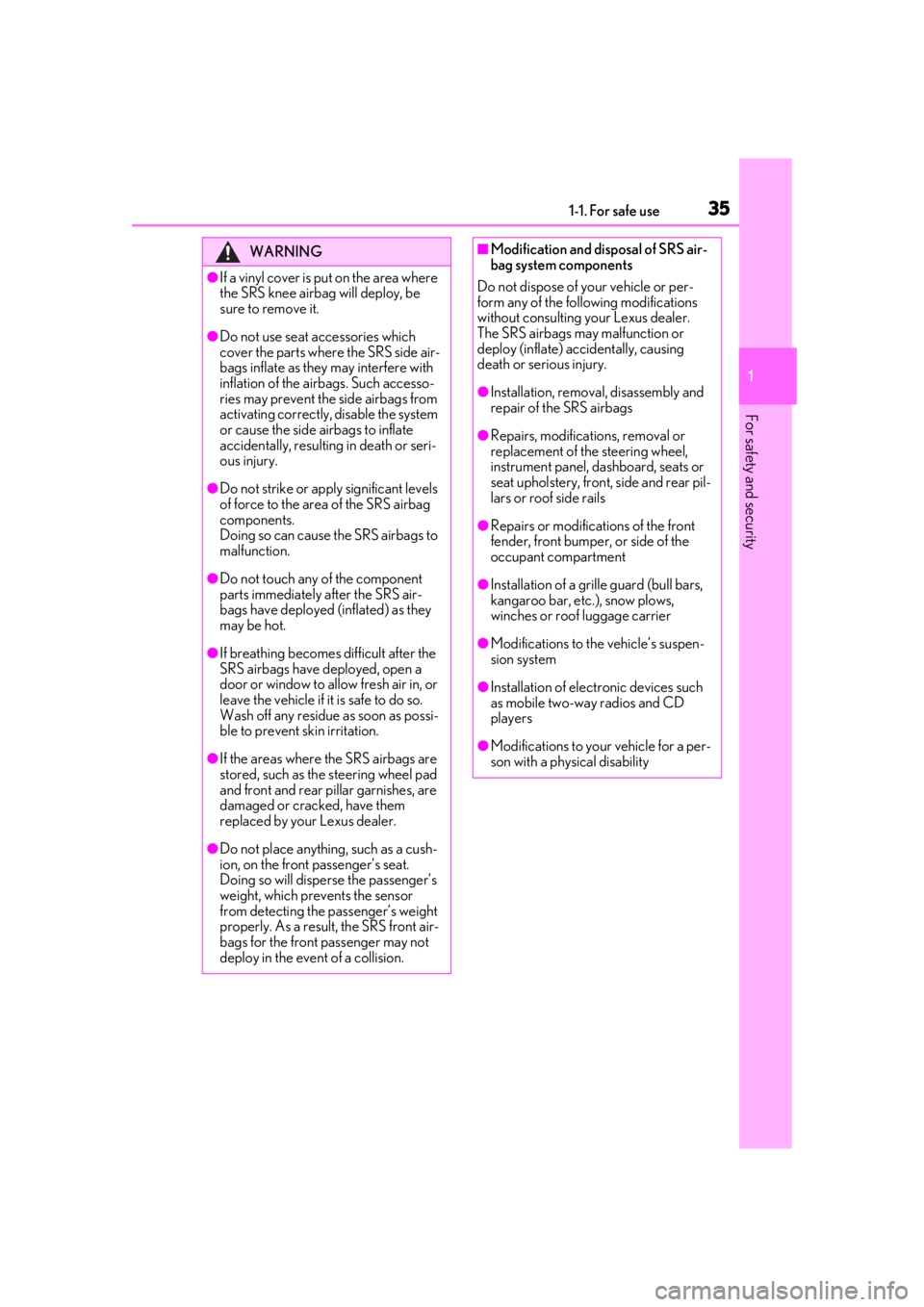
351-1. For safe use
1
For safety and security
WARNING
●If a vinyl cover is put on the area where
the SRS knee airbag will deploy, be
sure to remove it.
●Do not use seat accessories which
cover the parts where the SRS side air-
bags inflate as they may interfere with
inflation of the airbags. Such accesso-
ries may prevent the side airbags from
activating correctly, disable the system
or cause the side airbags to inflate
accidentally, resulting in death or seri-
ous injury.
●Do not strike or appl y significant levels
of force to the area of the SRS airbag
components.
Doing so can cause the SRS airbags to
malfunction.
●Do not touch any of the component
parts immediately after the SRS air-
bags have deployed (inflated) as they
may be hot.
●If breathing becomes difficult after the
SRS airbags have deployed, open a
door or window to allow fresh air in, or
leave the vehicle if it is safe to do so.
Wash off any residue as soon as possi-
ble to prevent skin irritation.
●If the areas where the SRS airbags are
stored, such as the steering wheel pad
and front and rear pillar garnishes, are
damaged or cracked, have them
replaced by your Lexus dealer.
●Do not place anything, such as a cush-
ion, on the front passenger’s seat.
Doing so will disperse the passenger’s
weight, which prevents the sensor
from detecting the passenger’s weight
properly. As a result, the SRS front air-
bags for the front passenger may not
deploy in the event of a collision.
■Modification and disposal of SRS air-
bag system components
Do not dispose of your vehicle or per-
form any of the following modifications
without consulting your Lexus dealer.
The SRS airbags may malfunction or
deploy (inflate) accidentally, causing
death or serious injury.
●Installation, remova l, disassembly and
repair of the SRS airbags
●Repairs, modifications, removal or
replacement of the steering wheel,
instrument panel, dashboard, seats or
seat upholstery, front, side and rear pil-
lars or roof side rails
●Repairs or modifications of the front
fender, front bumper, or side of the
occupant compartment
●Installation of a grille guard (bull bars,
kangaroo bar, etc. ), snow plows,
winches or roof luggage carrier
●Modifications to the vehicle’s suspen-
sion system
●Installation of elec tronic devices such
as mobile two-way radios and CD
players
●Modifications to your vehicle for a per-
son with a physical disability
Page 79 of 408
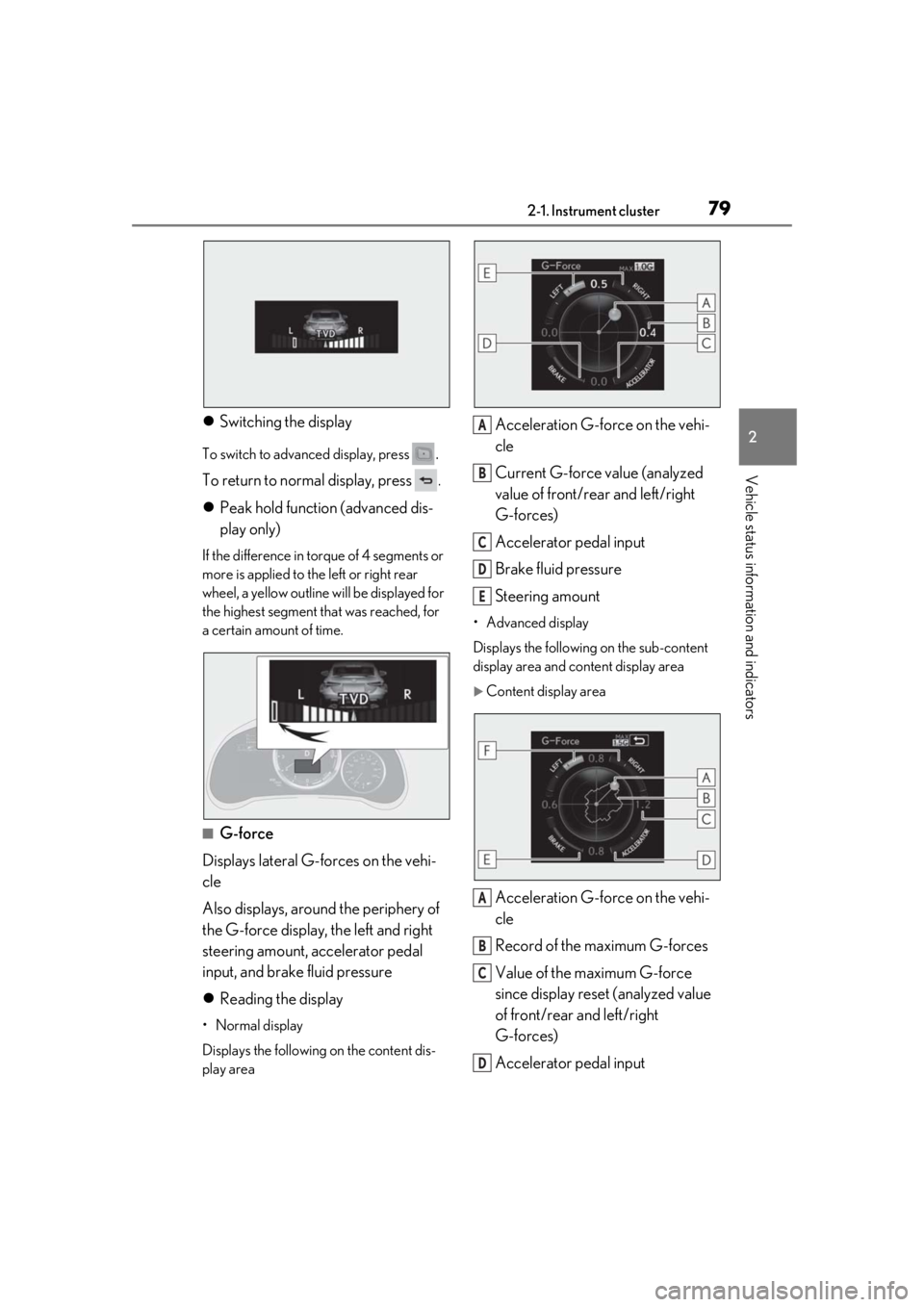
792-1. Instrument cluster
2
Vehicle status information and indicators
Switching the display
To switch to advanc ed display, press .
To return to normal display, press
.
Peak hold function (advanced dis-
play only)
If the difference in torque of 4 segments or
more is applied to th e left or right rear
wheel, a yellow outlin e will be displayed for
the highest segment that was reached, for
a certain amount of time.
■G-force
Displays lateral G-forces on the vehi-
cle
Also displays, around the periphery of
the G-force display, the left and right
steering amount, accelerator pedal
input, and brake fluid pressure
Reading the display
• Normal display
Displays the following on the content dis-
play area
Acceleration G-force on the vehi-
cle
Current G-force value (analyzed
value of front/rear and left/right
G-forces)
Accelerator pedal input
Brake fluid pressure
Steering amount
• Advanced display
Displays the following on the sub-content
display area and content display area
Content display area
Acceleration G-force on the vehi-
cle
Record of the maximum G-forces
Value of the maximum G-force
since display reset (analyzed value
of front/rear and left/right
G-forces)
Accelerator pedal input
A
B
C
D
E
A
B
C
D